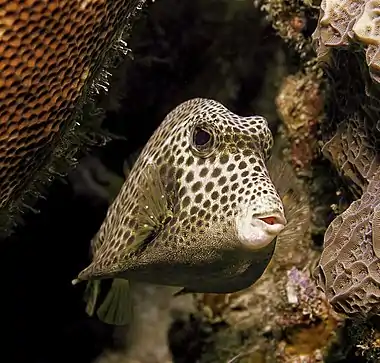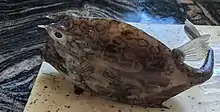Spotted trunkfish
The spotted trunkfish (Lactophrys bicaudalis) is a member of the family Ostraciidae. It lives in reefs throughout the Caribbean, as well as the southwestern Atlantic Ocean. It gets its name from the black spots on its whitish or yellow-golden body. In Caribbean countries, it is colloquially known as the boxfish, cow-fish or shellfish.[2][3]
| Spotted trunkfish | |
|---|---|
 | |
| Scientific classification | |
| Domain: | Eukaryota |
| Kingdom: | Animalia |
| Phylum: | Chordata |
| Class: | Actinopterygii |
| Order: | Tetraodontiformes |
| Family: | Ostraciidae |
| Genus: | Lactophrys |
| Species: | L. bicaudalis |
| Binomial name | |
| Lactophrys bicaudalis | |
| Synonyms | |
Description
Members of this family are known as boxfishes because they have a hard outer covering consisting of hexagonal plate-like scales fused together into a solid, triangular or box-like carapace.

The eyes, snout, fins and tail protrude from this. The spotted trunkfish is basically white or yellowish with a regular pattern of numerous black spots on the body and tailfin. Just behind the eye, adult fish have a diagonal row of three white spots where black ones would have been expected. The snout is plain white, with no spines above the eye and a pair of sharp spines in front of the anal fin.[4]
Distribution and habitat
The spotted trunkfish is found in the Caribbean Sea, the southern half of the Gulf of Mexico, Ascension Island and the northeastern coast of South America as far east as Brazil. It prefers clear water and is usually associated with coral reefs with fissures, holes and overhangs, at depths down to about 30 m (100 ft).[5]
Ecology
Because of the heavy armoured scales, the spotted trunkfish is normally limited to slow movements, performed by rippling its dorsal and anal fins and gently beating its pectoral fins. If faster motion is required, it can additionally use the tail fin for propulsion.[4] It is a benthic species, feeding on or near the seabed. Its diet includes crabs, shrimps, molluscs, sea urchins, starfish, brittle stars, sea cucumbers, tunicates and seagrasses.[5]
The spotted trunkfish, like all trunkfish of the genus Lactophrys, secretes a colourless toxin from glands on its skin when touched. The toxin is only dangerous when ingested, so there is no immediate harm to divers. Predators as large as nurse sharks can die from eating a trunkfish.[6]
References
- Leis, J.L.; Matsuura, K.; Shao, K.-T.; Hardy, G.; Zapfe, G.; Liu, M.; Jing, L.; Tyler, J.; Robertson, R. (2015). "Lactophrys bicaudalis". IUCN Red List of Threatened Species. 2015: e.T190106A1940651. doi:10.2305/IUCN.UK.2015-4.RLTS.T190106A1940651.en. Retrieved 2 June 2023.
- Allsopp, Richard (1996). Dictionary of Caribbean English Usage. p. 174. ISBN 9789766401450.
- Allsopp, Richard (1996). Dictionary of Caribbean English Usage. p. 503. ISBN 9789766401450.
- M. De Kluijver; G. Gijswijt; R. de Leon; I. da Cunda. "Spotted trunkfish: Lactophrys bicaudalis". Interactive Guide to Caribbean Diving. Marine Species Identification Portal. Retrieved 21 July 2020.
- "Lactophrys bicaudalis (Linnaeus, 1758):spotted trunkfish". FishBase. Retrieved 20 July 2020.
- Maurice Burton, Robert Burton. International Wildlife Encyclopedia. Marshall Cavendish, New York, 2002. ISBN 0-7614-7286-X; pp. 2758–2759
